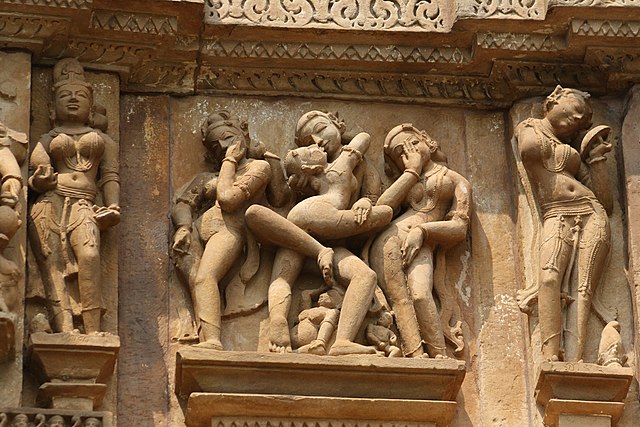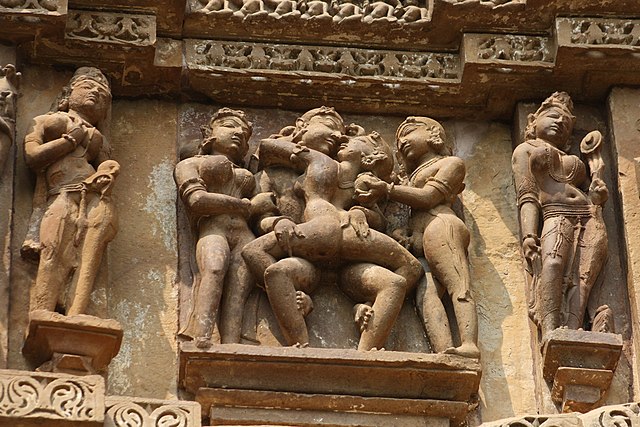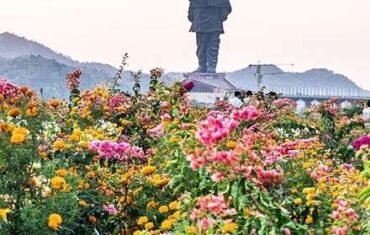Khajuraho is a small town in the Chhatarpur district of Madhya Pradesh, India, famous for its exquisite temples that showcase the rich cultural heritage of the Chandela dynasty. The Khajuraho Group of Monuments, a UNESCO World Heritage Site, consists of about 20 temples that belong to Hinduism and Jainism. Khajuraho Western Group of Temples were built between the 9th and 12th centuries CE by the Chandela rulers, who were patrons of art and architecture. Top 11 Places To Visit in Khajuraho
Khajuraho Western Group of Temples are renowned for their Nagara-style architectural symbolism and their erotic sculptures that depict various aspects of human life and spirituality. Visit during Khajuraho One Day Tour by cab
Location of Khajuraho Western Group of Temples

The Khajuraho temples are located about 175 kilometres (109 miles) southeast of Jhansi, 10 kilometres (6.2 miles) from Khajwa, 9 kilometres (5.6 miles) from Rajnagar, and 49 kilometres (30 miles) from district headquarter Chhatarpur. Khajuraho Western Group of Temples are spread over an area of six square kilometres (2.3 square miles), divided into three groups: Western, Eastern, and Southern. The Western group is the largest and most prominent, containing the finest and most elaborate temples. The Eastern group consists of mainly Jain temples, while the Southern group has a few Hindu temples.
Timing/Entry Fees of Khajuraho Western Group of Temples

The Western group of temples is open for visitors from sunrise to sunset, every day of the week. The entry fee for Indian nationals is Rs. 40 per person, while for foreign nationals it is Rs. 600 per person. Children below the age of 15 years are allowed free entry.
There is also a light and sound show in the evening, narrated by the Bollywood actor Amitabh Bachchan, that showcases the history and significance of the Khajuraho temples. The show timings are 6:30 pm to 7:25 pm in Hindi and 7:40 pm to 8:35 pm in English. The ticket price for the show is Rs. 250 for adults and Rs. 150 for children.
How to Reach Khajuraho Western Group of Temples

Khajuraho is well connected by road, rail, and air to major cities in India. The nearest airport is the Khajuraho Airport, which is about 9 kilometres (5.6 miles) from the town. There are regular flights from Delhi, Varanasi, and Agra to Khajuraho. The nearest railway station is the Khajuraho Railway Station, which is about 8 kilometres (5 miles) from the town. There are trains from Delhi, Agra, Jhansi, Bhopal, and Udaipur to Khajuraho.
The nearest bus stand is the Khajuraho Bus Stand, which is about 1 kilometre (0.6 miles) from the town. There are buses from Chhatarpur, Jhansi, Satna, and Panna to Khajuraho. One can also hire a taxi, auto-rickshaw, or cycle-rickshaw to reach the Western group of temples from the town.
Things to Do Khajuraho Western Group of Temples

The Western group of temples offers a lot of things to do for the visitors, apart from admiring the stunning architecture and sculptures. Some of the things to do are:
- Visit the Archaeological Museum, which is located near the Western group of temples. The museum displays a collection of sculptures, inscriptions, architectural fragments, and other artefacts from the Khajuraho temples. The museum is open from 10 am to 5 pm, except on Fridays. The entry fee is Rs. 10 per person.
- Enjoy a boat ride on the Khajur Sagar, a lake that lies adjacent to the Western group of temples. The lake offers a scenic view of the temples and the surrounding landscape. The boat ride costs Rs. 50 per person for 30 minutes.
- Explore the nearby attractions, such as the Raneh Falls, a natural waterfall that is about 20 kilometres (12 miles) from Khajuraho. The falls are formed by the Ken River and have a series of rock formations that create a canyon-like effect. The falls are best visited during the monsoon season, when the water level is high.
- Experience the local culture and cuisine, by visiting the Khajuraho Dance Festival, an annual event that is held in February or March. The festival showcases the classical dance forms of India, such as Bharatanatyam, Kathak, Odissi, Kuchipudi, and Manipuri. The festival is held in the open-air auditorium near the Chitragupta Temple and attracts performers and spectators from all over the world. The local cuisine of Khajuraho is influenced by the Bundelkhand region and consists of dishes such as bafla, dal, kusli, lavang lata, and mawa bati.
Significance of Khajuraho Western Group of Temples

The Khajuraho Western group of temples is significant for various reasons, such as:
- It represents the peak of the Chandela art and architecture, which was influenced by the Gupta and the Pratihara styles. The temples are built of sandstone, without any mortar, and have intricate carvings and sculptures that cover the walls, pillars, ceilings, and roofs. The temples have a common plan, consisting of a sanctum (garbhagriha), a vestibule (antarala), a hall (mandapa), and a porch (ardhamandapa). The sanctum is surmounted by a curvilinear tower (shikhara), which has smaller towers (urushringas) on its sides. The temples also have balconies, windows, and projections that add to the aesthetic appeal.
- It reflects the religious tolerance and diversity of the Chandela society, which patronized both Hinduism and Jainism. The temples are dedicated to various deities, such as Shiva, Vishnu, Devi, Surya, and the Tirthankaras. The temples also depict scenes from the Hindu epics, such as the Ramayana and the Mahabharata, as well as the Jain legends, such as the life of Mahavira. The temples also have images of various gods and goddesses, celestial beings, mythical creatures, animals, birds, and plants.
- It expresses the philosophy and worldview of the Chandela culture, which celebrated life and its various aspects. The temples are famous for their erotic sculptures, which constitute about 10% of the total sculptures. These sculptures depict various forms of love, such as romantic, erotic, maternal, and spiritual. The sculptures also illustrate the four goals of life in Hinduism, namely dharma (duty), artha (wealth), kama (pleasure), and moksha (liberation). The sculptures also symbolize the union of the male and female principles, which is the essence of creation.
FAQ’s
Some of the frequently asked questions about the Khajuraho Western group of temples are:
Q: Why are the Khajuraho Western Group of Temples famous for their erotic sculptures?
A: The Khajuraho Western Group of Temples are famous for their erotic sculptures because they represent the Chandela culture, which was open and liberal about sexuality and spirituality. The erotic sculptures are not meant to be vulgar or obscene, but rather to depict the beauty and joy of life. The erotic sculptures also have a deeper meaning, as they symbolize the union of the male and female principles, which is the essence of creation.
Q: How many temples are there in the Khajuraho Western Group of Temples?
A: There are nine temples in the Khajuraho Western Group of Temples, namely:
Lakshmana Temple: Dedicated to Vishnu, this temple is the oldest and the most ornate in the Western group. It was built by King Yashovarman in the 10th century CE. The temple has a three-headed idol of Vishnu, known as Vaikuntha, in the sanctum. The temple also has sculptures of various deities, such as Brahma, Shiva, Ganesha, and Durga.
Kandariya Mahadeva Temple: Dedicated to Shiva, this temple is the largest and the most magnificent in the Western group. It was built by King Vidyadhara in the 11th century CE. The temple has a linga, the symbol of Shiva, in the sanctum. The temple also has over 800 sculptures of various themes, such as gods, goddesses, celestial beings, mythical creatures, animals, birds, plants, and erotic scenes.
Devi Jagadambi Temple: Dedicated to Devi, this temple is one of the most elegant and graceful in the Western group. It was built by King Vidyadhara in the 11th century CE. The temple has an image of Parvati, the consort of Shiva, in the sanctum. The temple also has sculptures of various deities, such as Vishnu, Ganesha, and Surya.
Vishwanatha Temple: Dedicated to Shiva, this temple is one of the most impressive and imposing in the Western group. It was built by King Dhanga in the 11th century CE. The temple has a linga, the symbol of Shiva, in the sanctum. The temple also has sculptures of various deities, such as Brahma, Vishnu, Ganesha, and Kartikeya. The temple also has a massive stone image of Nandi, the bull mount of Shiva, facing the temple entrance.
Nandi Temple: Dedicated to Nandi, this temple is a small and simple shrine located opposite the Vishwanatha Temple. It was built by King Dhanga in the 11th century CE. The temple has a stone image of Nandi, the bull mount of Shiva, in the sanctum. The temple also has sculptures of various animals, such as elephants, lions, and horses.
Lakshmana Temple: Dedicated to Vishnu, this temple is one of the oldest and most complete in the Western group. It was built by King Yashovarman in the 10th century CE. The temple has a four-armed image of Vishnu, known as Vaikuntha, in the sanctum. The temple also has sculptures of various deities, such as Shiva, Ganesha, Durga, and Surya. The temple also has a frieze of over 600 erotic sculptures on the exterior walls.
Matangeshwara Temple: Dedicated to Shiva, this temple is one of the simplest and plainest in the Western group. It was built by King Chandravarman in the 9th century CE. The temple has a huge linga, the symbol of Shiva, in the sanctum. The temple also has sculptures of various deities, such as Vishnu, Ganesha, and Kartikeya. The temple is still in active worship and is open to the public.
Chausath Yogini Temple: Dedicated to the 64 yoginis, this temple is one of the oldest and most unique in the Western group. It was built by King Chandravarman in the 9th century CE. The temple is a circular structure with 64 cells, each containing a stone image of a yogini, a female attendant of the goddess Durga. The temple also has a central shrine, which is now empty, but was probably dedicated to Durga or Shiva. The temple is open to the sky and has no roof.
Conclusion
The Khajuraho Western group of temples is a marvel of Indian art and architecture, that showcases the rich cultural heritage of the Chandela dynasty. Khajuraho Western Group of Temples are a testimony to the religious tolerance and diversity of the Chandela society, that patronized both Hinduism and Jainism. Khajuraho Western Group of Temples are also a reflection of the philosophy and worldview of the Chandela culture, that celebrated life and its various aspects.
Khajuraho Western Group of Temples are famous for their Nagara-style architectural symbolism and their erotic sculptures that depict various aspects of human life and spirituality. Khajuraho Western Group of Temples are a must-visit for anyone who wants to witness the beauty and glory of ancient Indian civilization.










